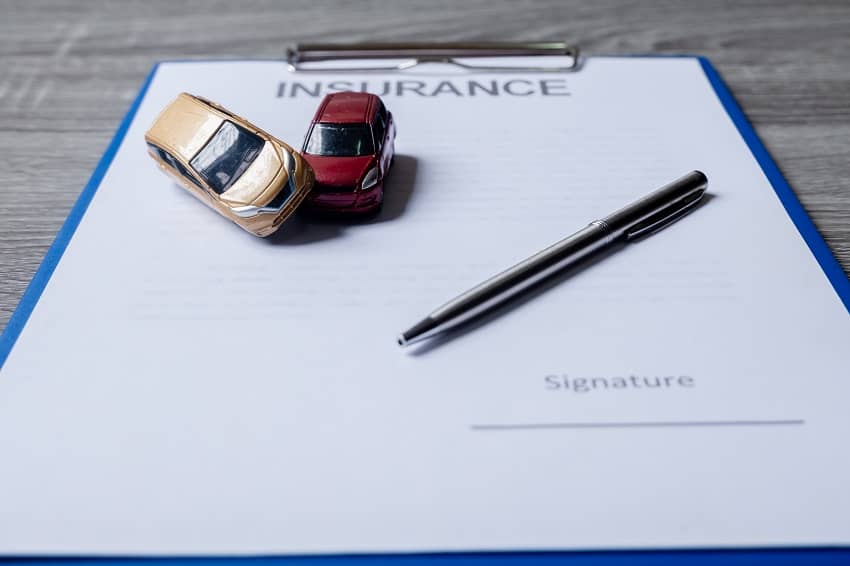Car insurance deductible is the amount that a policyholder is required to pay out-of-pocket before insurance coverage kicks in. Car insurance deductible refers to the portion of an insurance claim that a policyholder is responsible for paying.
This means that if a car accident occurs and the policyholder has a deductible of $500, they would have to pay that amount before the insurance company would cover the rest of the costs. A higher deductible typically results in lower monthly premiums for the policyholder, but a lower deductible means less money out-of-pocket in the event of an accident.
Understanding car insurance deductibles is crucial for all drivers to ensure they have proper coverage and are not caught off-guard in the event of an accident.
Table of Contents
Types Of Car Insurance Deductibles
Car insurance can be a confusing topic, but understanding the different types of coverage and deductibles is essential for all car owners. A car insurance deductible refers to the amount you agree to pay out of pocket before your insurance company reimburses you for damages or losses.
We’ll delve into the different types of car insurance deductibles.
Comprehensive Deductible
Comprehensive coverage typically covers damage to your car caused by incidents other than a collision, such as hail, theft, fire, or vandalism. If you have comprehensive coverage, you’ll have a deductible amount that you’ll pay before your insurance company covers the remaining repair costs.
Here are some key points to keep in mind regarding comprehensive deductibles:
- Generally, the lower your deductible, the higher your insurance premium will be.
- Comprehensive deductibles are usually in the range of $100 to $1,000 depending on your policy.
- If your car is totaled or stolen, your comprehensive deductible will apply if you have comprehensive coverage.
Collision Deductible
Collision coverage covers damage to your car caused by an accident with another car or an object. Similar to comprehensive coverage, you’ll have a deductible with collision coverage. Here are some important things to remember about collision deductibles:
- Just like with comprehensive coverage, a lower deductible means a higher premium.
- Deductibles for collision coverage are often similar to comprehensive coverage deductibles with a range of $100 to $1,000 depending on your policy.
- Your collision deductible applies regardless of who is at fault for the accident.
Personal Injury Protection Deductible
Personal injury protection (pip) is a type of car insurance that covers medical expenses for you and your passengers in case of an accident, regardless of who is at fault. Here’s what you need to know about pip deductible:
- Pip coverage is optional in most states.
- Pip deductibles are usually in the range of $250 to $1,000 per person, but this varies by state and policy.
- Your pip deductible applies to each claim filed, not per accident.
Uninsured Motorist Deductible
Uninsured motorist coverage (umc) protects you in the event that you’re in an accident with a driver who doesn’t have car insurance. Umc typically includes both bodily injury and property damage coverage. Below are some crucial things to remember about umc deductibles:
- The deductible for uninsured motorist coverage varies by state, but it’s usually in the range of $200 to $1,000 per accident.
- Umc coverage is optional in most states but may be required in certain states.
- Your umc deductible applies regardless of who is at fault for the accident.
Understanding the different types of car insurance deductibles is essential to ensure that you have sufficient coverage for your car. Keep in mind that your deductible amount affects your premium, so ensure that you choose wisely based on your budget and your car’s value.
Choosing The Right Car Insurance Deductible
Car insurance can often seem like a confusing and complex process, with numerous terms and conditions that can be challenging to understand. One of the terms that you will undoubtedly encounter when navigating the process of car insurance is the deductible.
Put simply, a deductible is the amount of money that you will agree to pay out of your pocket for damages incurred in a car accident before your insurance coverage begins to apply.
Factors To Consider
When determining the deductible that is right for you, there are several factors that you should take into account:
- Your budget: The primary factor to consider when choosing a car insurance deductible is your finances. You should only select a deductible that you can comfortably afford to pay if an accident occurs.
- The value of your car: If you have an expensive car that is worth a lot of money, it may make sense to choose a lower deductible, as this will require less out-of-pocket expense in the event of an accident.
- Risk tolerance: Depending on the level of risk you are comfortable carrying, you can either select a higher deductible or a lower one. If you feel more comfortable taking on less risk, a lower deductible will be more suitable.
- Driving record: If your driving record is not spotless, it may make more sense to choose a lower deductible as you may be more prone to accidents than an individual with a clean driving record.
High Vs. Low Deductibles
When it comes to choosing between high and low deductibles, there are several advantages and disadvantages to consider.
High Deductibles
- Cost-effective premiums: Choosing a higher deductible can result in a significant reduction in your monthly premiums.
- Encourages safe driving: By selecting a high deductible, you can encourage yourself to drive more carefully and with more caution to reduce the possibility of an accident happening.
Low Deductibles
- Peace of mind: A lower deductible can give you peace of mind knowing that you can afford to pay for damages incurred in an accident without being financially stressed.
- Faster payout: If you are involved in an accident and need to file a claim, a lower deductible will result in your insurance provider paying out faster than if you had a higher deductible.
The deductible you choose for your car insurance policy plays a crucial role in the overall coverage you will receive if you get into an accident. It’s essential to take time when deciding on a deductible and choose one that aligns with your financial, personal, and driving criteria.
How Car Insurance Deductible Affects Premiums
Car insurance is a necessity for anyone who drives a vehicle, but it can be confusing to understand how all the different components work. One such component is the deductible. We will provide a complete guide to understanding car insurance deductibles and how they affect premiums.
Specifically, we will explore the relationship between deductibles and premiums and provide examples and scenarios to illustrate this relationship.
Relationship Between Deductibles And Premiums
The deductible for car insurance is the amount that must be paid by the policyholder before the insurance coverage kicks in. This means that if you have a deductible of $500 and you are in an accident that results in $1,000 of damage to your car, you will need to pay $500 and the insurance will cover the remaining $500.
The deductible and premium are inversely related, meaning that the higher the deductible, the lower the premium, and vice versa. This is because by choosing a higher deductible, policyholders are taking on more risk and are therefore less likely to file a claim.
As a result, the insurance company is less likely to have to pay out money and can offer a lower premium.
Conversely, if policyholders choose a lower deductible, their premium will be higher because the insurance company is taking on more risk and is more likely to have to pay out money.
Examples And Scenarios
Let’s look at some examples to better understand how this relationship works:
- Example 1: Emily has a car insurance premium of $100 per month with a $500 deductible. She decides to increase her deductible to $1,000. As a result, her monthly premium decreases to $80.
- Example 2: John has a car insurance premium of $150 per month with a $250 deductible. He decides to decrease his deductible to $100. As a result, his monthly premium increases to $200.
- Scenario 1: Sarah has a clean driving record and feels that she is unlikely to get into an accident. She chooses a high deductible of $1,000 to lower her monthly premium.
- Scenario 2: David has a history of speeding tickets and has been in several accidents in the past. He chooses a low deductible of $250 because he feels that he is more likely to file a claim.
The deductible and premium are closely linked in car insurance, and policyholders should carefully consider their options when choosing these values. By understanding this relationship and selecting the right deductible, policyholders can ensure that they are getting the best coverage for their needs at an affordable price.
How To File A Claim With Car Insurance Deductible
Car insurance deductible refers to the amount you pay out of pocket in case of an accident or damages covered by your car insurance policy. The deductible amount can vary depending on different insurance policies and can range between $200 to $2,000.
While it can lower your car insurance premium, you need to pay this predetermined deductible before your insurance company covers the remaining damages.
Process Of Filing A Claim
Filing a claim with your car insurance deductible is an easy process. Here are the steps to follow:
- Contact your insurance company: Immediately contact your insurance company and inform them about the accident or damages incurred.
- Provide details of the incident: You need to provide your insurance company with all the necessary information, including date and time of the incident, location, and details of the damages caused.
- Submit a claims form: Your insurance company will provide you with a claims form to fill out and submit to initiate the claim process.
- Wait for the adjuster’s assessment: Once your claim is submitted, an adjuster will be assigned to assess the damages, which may include inspecting your car and reviewing the police report.
Tips For Filing A Claim Successfully
Filing a car insurance claim with a deductible can be a hassle, but following these tips can help you file your claim successfully:
- Document the incident: Take pictures of the damages and collect evidence such as police reports, witness statements, and medical bills if applicable.
- Stay organized: Keep a record of all relevant documents related to the claim, including your insurance policy agreement, claim form, and correspondence with your insurance company.
- Keep communication open: Stay in contact with your insurance company and ask clarifying questions if you need to.
- Be honest and accurate: Ensure that your information is accurate, and do not exaggerate details to avoid any potential fraud charges.
- Understand your coverage: Review your policy agreement to understand your coverage limits, including the deductible amount, and ensure you meet the requirements to file a claim.
Understanding how to file a claim with car insurance deductible is essential in case of an accident or damages covered under your insurance policy. If you follow the correct steps and stay organized with your documentation, you can file your claims successfully and receive the necessary reimbursement to cover the damages.
Frequently Asked Questions On What Is Car Insurance Deductible
What Is A Car Insurance Deductible?
A car insurance deductible is the amount you pay out of pocket before insurance coverage kicks in. For instance, if you have an accident with a $1,000 deductible and $5,000 in covered damages, you’re responsible for paying the first $1,000.
How Does Car Insurance Deductible Work?
A deductible is the amount of money you agree to pay before your insurance company steps in to cover the remaining cost. For instance, if your damage cost is $3,000 and you have a deductible of $500, you’ll pay $500, and your insurer will pay the remaining $2,500.
How Do I Choose A Car Insurance Deductible?
Selecting the right deductible for your auto insurance policy isn’t a one-size-fits-all decision. Determine how much money you feel comfortable paying out of pocket in a situation before you make a claim. If you have enough money to pay the deductible without straining your budget, consider choosing a higher deductible to save money on insurance premiums.
Can I Change My Car Insurance Deductible?
Yes, you can file a request for a deductible change with your car insurance provider. However, keep in mind that raising your deductible could lower your premium but could also put you at risk of paying more out-of-pocket in an unfortunate event of an accident.
How Does A Car Insurance Deductible Affect My Premium?
Generally, choosing a higher deductible lowers your premium while a lower deductible increases it. For instance, if your car insurance premium is $1,500, and you choose a $1,000 deductible, your premium can decrease to $1,300 or $1,200. Nonetheless, ensure the deductible you choose is affordable in case of an accident.
Conclusion
After reading this article, you should now have a better understanding of what a car insurance deductible is and how it works. The amount of your deductible can affect both your premium and your out-of-pocket expenses if you need to file a claim.
While choosing a higher deductible can lower your premium, it can also leave you with a larger financial burden in the event of an accident. On the other hand, a lower deductible may result in a higher premium but lower out-of-pocket expenses if you need to file a claim.
It’s important to make an informed decision based on your own financial situation and risk tolerance. By comparing different deductible options and working with a reputable insurance provider, you can feel confident in your car insurance coverage and prepare for any unexpected events on the road.




